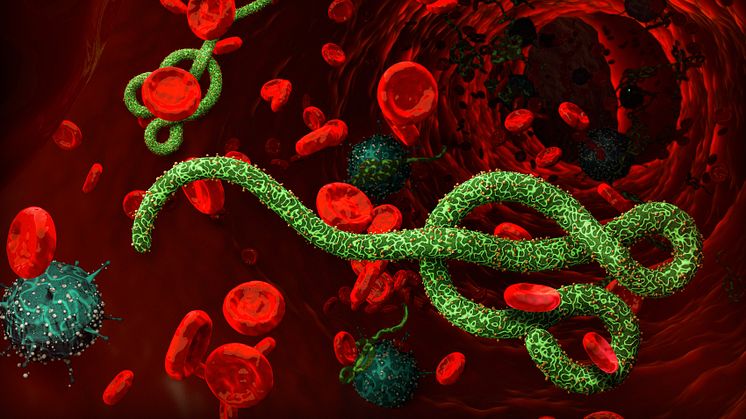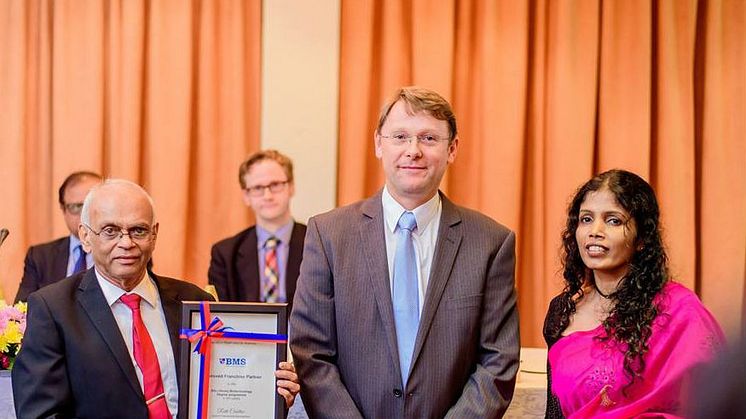
Press release -
Breakthrough in rapid, mass screening for the Ebola virus
A new, faster and safer way of diagnosing the Ebola virus has been developed by an academic from Northumbria University, Newcastle.
Ebola diagnosis from Northumbria University on Vimeo.
Research led and carried out by Dr Sterghios Moschos at Northumbria means that patients with Ebola-like symptoms can be identified and treated much sooner and at the point of care, helping to reduce the spread of the disease and risks to others.
During the Ebola outbreak in Africa in 2014, patients tested for the disease had to provide a blood sample fortesting in a specialist lab by highly trained staff.,There are only a few of these facilities in the world,including Public Health England’s Lab in Porton Down in the UK, with each diagnosis of the Ebola virus genome taking between5-8 hours to confirm.
Thanks to the efforts of Dr Moschos’ research team, working with a manufacturer of innovative diagnostic solutions, a new point of care diagnostic platform – EbolaCheck - has been developed, which can be deployed to the scene of an outbreak. The test can now be carried out on an amount of blood that is 700 times smaller than previously needed - literally a drop obtained by ‘pin pricking’ a finger - and it now takes less than 70 minutes to complete. As a result, the test is much safer to administer, requires minimal training and reduces the cost of diagnosis significantly. Crucially, its performance is comparable to laboratory testing, meaning any patient with symptoms of Ebola can be safely and reliably diagnosed.
The research has been funded by a grant from Elrha’s Research for Health in Humanitarian Crises (R2HC) Programme, and uses proprietary technology developed by BioGene Ltd. The prototype is called the ‘QuRapID’.
The R2HC programme aims to improve health outcomes by strengthening the evidence base for public health interventions in humanitarian crises. In response to the Ebola outbreak in West Africa, R2HC launched an emergency Ebola Health Research Call in August 2014, aiming to fund research which would help to strengthen interventions to tackle this and future outbreaks.
BioGene Limited are based near Cambridge and provide a 'solution-based' portfolio of products, services and support - to encompass the key application areas of molecular biology to include Nucleic Acid Purification, Target Amplification and Post-Amplification Analyses.
A number of organisations have been involved in the research, including BG Research Ltd, the University of Westminster, Public Health England, Flurogenics Ltd, Diagnostic Systems Division and Virology Division of the United States Army Medical Research Institute of Infectious Diseases and Kwame Nkrumah University of Science and Technology in Ghana.
The technology could also be used in the diagnosis of other high-risk viruses such as the Zika, MERS, SARS, flu, and dengue viruses, but also bacterial and parasite infections, including meningitis and malaria. This is because it detects and measures genes and genomes and so has broader applications in medicine.
Dr Sterghios A. Moschos, Associate Professor of Cellular and Molecular Sciences at Northumbria University, led the research. He said: “During the Ebola outbreak, between 2013 & 2016, over 28,500 individuals contracted the disease with a mortality rate of 39.5%. These people often had to walk for hours to reach overflowing treatment centres, or wait for days for samples to be processed. Some were put at risk having to wait next to probable Ebola virus cases for an ‘all clear’- usually because the symptoms of other diseases, like malaria, made them fear they had the Ebola virus.
“The development of this pioneering technology could essentially save lives and reduce the spread of the disease, which is crucial in a humanitarian crisis. Due to there being no further cases since it was developed, to date, it has not been possible to take the test out of the lab, into the field, where the patient needs it. However, it can be deployed anywhere - the frontline in Africa where this disease is found, as well as international airports and ports - to help stop the disease from spreading and to prevent disruption of international trade and travel. It could also be used in the diagnosis of other infectious diseases, as well as bringing genetic testing to the shop front, for example in a pharmacy or a GP surgery.”
Nelson Nazareth, Managing Director of BioGene Ltd, which developed and manufactured the equipment, said: “We are delighted to have worked with Dr Moschos and his team on the project. BioGene is at the forefront of innovative, UltraRapid Molecular Biology solutions for rapid detection of nucleic acids and this research has led to a very exciting platform technology, and one that we are looking to develop further.”
Dr Moschos’ research findings are published in The Royal Society of Chemistry’s, Chemical Sciencehttp://pubs.rsc.org/en/content/articlelanding/2017/sc/c7sc03281a#!divAbstract
Dr Moschos’ research findings have also been published via Chemistry World and can be found here
For more information about research at Northumbria University, visit www.northumbria.ac.uk/research
For more information about Elrha’s Research for Health in Humanitarian Crises (R2HC) programme visit www.elrha.org/work/r2hc for more information.
For further information on news at Northumbria, go to www.northumbria.ac.uk/news
Captions:Dr Sterghios A Moschos, Associate Professor of Cellular and Molecular Sciences, Northumbria University, Newcastle
The Ebola Virus
Film: https://vimeo.com/235868272
Elrha’s R2HC programme is funded equally by the Wellcome Trust and UK Government.
The Ebola virus causes an acute, serious illness which is often fatal if untreated. Ebola virus disease (EVD) first appeared in 1976 in two simultaneous outbreaks, one in what is now, Nzara, South Sudan, and the other in Yambuku, Democratic Republic of Congo. The latter occurred in a village near the Ebola River, from which the disease takes its name. The 2014–2016 outbreak in West Africa was the largest and most complex Ebola outbreak since the virus was first discovered in 1976. There were more cases and deaths in this outbreak than all others combined. It also spread between countries, starting in Guinea then moving across land borders to Sierra Leone and Liberia. It is thought that fruit bats of the Pteropodidae family are natural Ebola virus hosts. Ebola is introduced into the human population through close contact with the blood, secretions, organs or other bodily fluids of infected animals such as chimpanzees, gorillas, fruit bats, monkeys, forest antelope and porcupines found ill or dead or in the rainforest. It then spreads through human-to-human transmission via direct contact (through broken skin or mucous membranes) with the blood, secretions, organs or other bodily fluids of infected people, and with surfaces and materials (e.g. bedding, clothing) contaminated with these fluids. (Source: World Health Organization)
Topics
Categories
Northumbria is a research-rich, business-focused, professional university with a global reputation for academic excellence. To find out more about our courses go to www.northumbria.ac.uk
If you have a media enquiry please contact our Media and Communications team at media.communications@northumbria.ac.uk or call 0191 227 4604.








